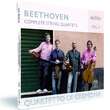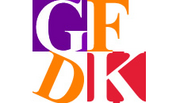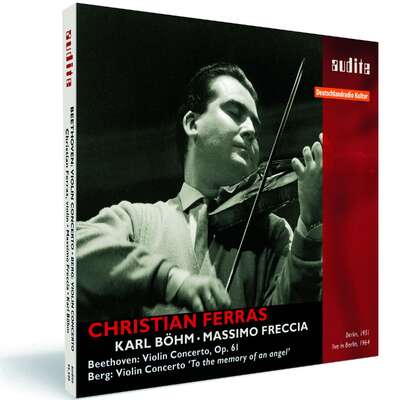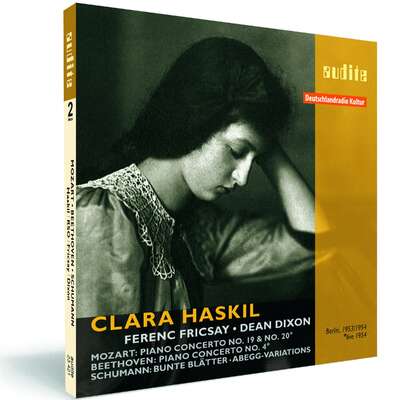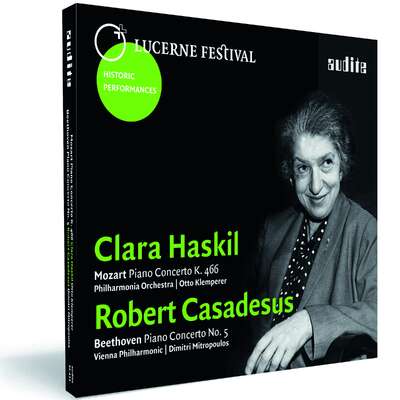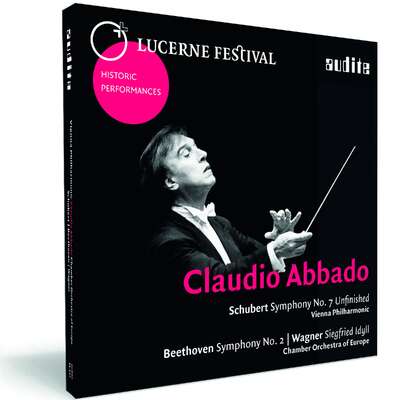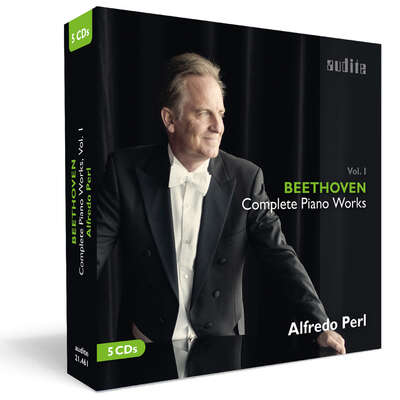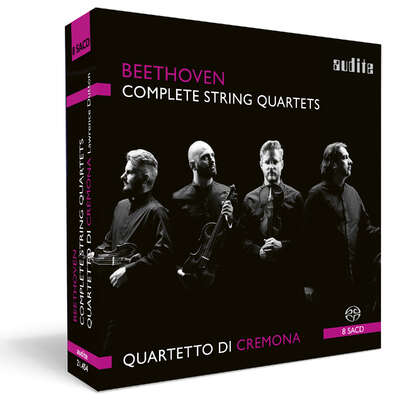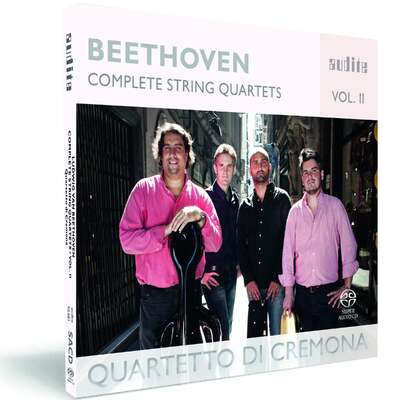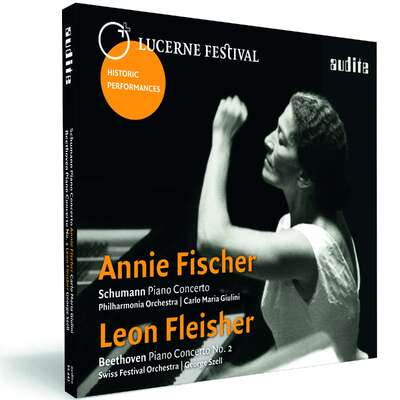
During the past ten years the Quartetto di Cremona has matured into a string quartet of international renown, combining the Italian culture of string playing with an awareness of historical performance practice. The first volume of their recording series of the Complete Beethoven String Quartets comprises three distinctive works from Beethoven’s early, middle and late periods.more
"The sheer power, energy and attack from the group, on my first hearing of the disc, totally took my breath away." (The Herald Scotland)
Details
|
Ludwig van Beethoven: Complete String Quartets - Vol. 1
String Quartets Op. 18 No. 6, Op. 95 & Op. 135 |
|
| article number: | 92.680 |
|---|---|
| EAN barcode: | 4022143926807 |
| price group: | ACX |
| release date: | 15. March 2013 |
| total time: | 67 min. |
Bonus Material
Informationen
During the past ten years the Quartetto di Cremona has matured into a string quartet of international renown, combining the Italian culture of string playing with an awareness of historical performance practice. Having for many years performed at the great international halls, it is often regarded as the successor to the famous Quartetto Italiano. The musical style of the Quartetto di Cremona is marked by a fruitful tension between Italian and German-Austrian influences: Following their academic studies the players continued their training with Piero Farulli of the Quartetto Italiano. He strongly favoured intuitive playing and a fervent, emotional, romantic and "Italian" approach to music. Afterwards the musicians pursued their studies with Hatto Beyerle of the Alban Berg Quartet who represents a clear, classical, "German-Austrian" style, focusing on faithfulness to the original, form and structure as a basis for musical interpretation and inspiration. Both teachers have left a lasting impression on the quartet and significantly influenced its musical style. The players naturally unite both poles, combining boisterous enthusiasm with a distinct sense for musical architecture, cultivating the fusion of structure and expression, external shape and internal passion.
With the three works contained in Volume 1, the Quartetto di Cremona covers the most important periods of Beethoven's quartet oeuvre. The final of the six Op. 18 Quartets features a mysteriously programmatic dimension in its last movement, "La Malinconia", whereas Op. 95 from Beethoven's middle period is both highly compact yet dramatically gripping. The disc closes with Beethoven's final Quartet, Op. 135, completed in Vienna one year before his death: it differs from his less easily approachable late works in taking on a conciliatory stance.
instruments:
violin I • Guarneri del Gesù (Cristiano Gualco)
violin II • Giovanni Battista Guadagnini (Paolo Andreoli)
viola • Strumento anonimo del 1680 di Scuola Piemontese (Simone Gramaglia)
cello • Marino Capicchioni del 1974 (Giovanni Scaglione)
Reviews
deropernfreund.de | 24.8.2017 | Egon Bezold | August 24, 2017 | source: http://www.derop... Edle kammermusikalische Kost
Welches Quartett kann es sich schon leisten am Mikrokosmos der Beethoven-Streichquartette vorüberzugehen? Die komplette Edition hat das Cremona TeamMehr lesen
Simone Gramaglia meldet sich in den Mittelstimmen zu Wort. Mit Klang und Kraft bedient Giovanni Scaglione den Cello-Part. Was die Vierertruppe auszeichnet ist die artikulationskräftig erfrischende Art wie der Quartett-Text verdeutlicht wird, ohne dass jemand auf den Gedanken käme allzu deutlich mit dem didaktischen Zeigefinger aufzuzeigen.
Voller Überraschungen steckt die Wiedergabe der frühen sechs Quartette aus op. 18, die aufgrund der stilistischen Problematik mit zu den vertracktesten des Quartett-Zyklus zählen. So flitzen die schnellen Sätze als Kabinettstücke in spieltechnischer Präzision vorüber. Flexibel reagiert die Viererformation auf die Stimmungsumschwünge. Schlüssige Tempi markieren den Pulsschlag einer glutvollen Wiedergabe. Da wird nicht nur der Geist Haydns und Mozarts geweckt, sondern auch der mittlere und späte Beethoven vorausgedacht. Den klingenden Beweis liefern die kurzangerissenen Akkorde aus dem c-Moll op. 18,4. Auch das heikle Quartett op.18,5 gerät zum spannungsgeladenen Akt für fein ziselierte, nervig rhythmisierte Quartettkunst.
Hohe interpretatorische Intelligenz charakterisiert die Wiedergabe der mittleren Werkgruppe op. 59. Als eminent schweres Prüfstück erweist sich für die Primgeige das e-Moll Nr. 2, das Günther Pichler, der Ex-Primarius des Alban Berg Quartetts, als vertrackter als den Solopart des Beethoven-Violinkonzerts charakterisiert hat. Und es stimmt alles: die Spieltechnik, die sensibel ausgeschriebenen Übergänge, auch die vibrierenden Sechzehntelpassagen, die in der sich verflüchtenden Atmosphäre zu Tage treten. Welch fein abgetönte Stimmung prägt das ruhig genommene, breit ausgespielte „Adagio con sentimento“, das vorbildlich ausgewogen im Ausdruck fasziniert. Atem nehmend die akrobatische Fuge aus dem dritten Quartett, die selbst für ein professionelles Team eine Hürde darstellt. Dass dieser Sturmlauf wohl zum radikalsten gehört, was in der Sektion „Perpetuum mobile“ geschrieben wurde, machen die Cremona Leute klangartistisch zur Hetzjagd nach Noten.
Zur klanglichen Delikatesse gerät das Finale des ersten Satzes aus dem „Harfenquartett“ op. 74. Unwirsch springt einen das f-Moll Quartett op. 95 ins Gesicht. Da wird der musikalische Trotz buchstäblich auf die Spitze getrieben. Der große Gipfelsturm auf die Monster der späten Quartette, wo sich Spiritualität und geistiger Anspruch auf faszinierende Weise durchdringen, beginnt mit dem Es-Dur Quartett op. 127. Organisch gelingt die Darstellung, nirgends wird der natürliche Strom der Musik unterbrochen. So gewinnt das endlos fließende durch subtiles Variationenwerk angereicherte Adagio troppo, molto cantabile durch Ausspielen der harmonischen Reibungen besonders an Leuchtkraft. Dieser ausladende Satz wird mit viel Innenspannung aufgeladen. Da ist ein Auseinanderbröckeln ausgeschlossen. Mit welcher Reaktionsfähigkeit das Team die Stimmungsumschwünge realisiert, macht Staunen. Zum Quartett-Komplex zählt auch die Große Fuge B-Dur op.133 – ein nachkomponierter Bestandteil, der 6. Satz der Originalversion des Quartetts op. 130. Zu bewundern ist auch im a-Moll op. 132 der wunderbar ausgespielte „Heiliger Dankgesang eines Genesenden an die Gottheit“. Energisch durchgeformt erscheint das Alla marchia des vierten Satzes und die fulminant hoch wirbelnde Final-Stretta.
Die suitenartig aneinander gereihten Abschnitte im cis-Moll Quartett op. 131, die Beethoven ja auf das Komplizierteste nahtlos miteinander verzahnte, stiften überzeugende Einheit. Da werden die durchsichtig gespielten Details, die liberal behandelte Sonate nie aus dem Auge verloren. Im ersten Allegro kommen die Akzente konturenscharf. Innere Ruhe verströmen die schier endlos sich hin dehnenden Variationen. Es gibt keine Stimmenkorrespondenz, keine rhythmische Spannung, kein dynamischen Ansatz, über die vom Vierer Team flüchtig hinweg gespielt worden wäre. Von bohrender Kraft und beispielhaftem Standvermögen kündet der Finalsatz.
Diese exemplarische Auslegung bannt die Tontechnik auf das Format „Souround Sound – spielbar auf CD und SACD Player“. Das kammermusikalische Profil öffnet reizvolle kompositorische Perspektiven, vermittelt einen tiefen Einblick in Beethovens kammermusikalische Meisterschaft. Schulbildend für die Cremona Gruppe ist der Deutsch-Österreichische klassisch geprägte Stil (in Bezug auf Werktreue, Form und Stil) wie von Hatto Beyerle vom Alban Berg Quartett und in Fortsetzung von Piero Farulli vom Quartetto Italiano gepflegt wurde. Hier verbinden sich ein leidenschaftlich-emotionaler Ansatz mit romantisch geprägten Elementen sowie italienischer klanglicher Ästhetik. Da verschmelzen Struktur, Ausdruck und Form zur glühenden inneren Leidenschaft.
Stereoplay | 09|2016 | Lothar Brandt | September 1, 2016 HighClass in HiRes
Für seine beherzte Mischung aus "italienischer" Leidenschaft und "deutsch-österreichischem" Strukturbewusstsein steht ihre ausgefeilte Wiedergabe des Kopfsatzes des frühen Opus 18 Nr. 6.Mehr lesen
CD Classico | 01.05.2014 | Andrea Bedetti | May 1, 2014
Chiunque affronti il corpus die Quartetti per archi di Beethoven saMehr lesen
ensuite Kulturmagazin | Nr. 134 | Februar 2014 | Francois Lilienfeld | February 1, 2014 Amadeus-Quartett in Berlin
Als drei nach dem «Anschluß» 1938 aus Wien geflüchtete jüdische Geiger sich 1940 in einem Internierungslager auf der Isle of Man kennenlernten,Mehr lesen
Die drei Geiger wurden Schüler von Max Rostal, der aIs großartiger Interpret und Pädagoge auch in Bern längere Zeit heimisch werden sollte. Durch die Rostal-Schülerin Suzanne Rozsa lernte das Trio den Cellisten Martin Lovett kennen, der später ihr Mann wurde. Schnell reifte der Entschluss, mit ihm ein Quartett zu gründen, mit Norbert Brainin (Erste Geige), Siegmund Nissel (Zweite Geige) und Peter Schidlof (Bratsche). Der erste Auftritt fand im Sommer 1947 in der Grafschaft Devon statt, der erste Triumph in der Londoner Wigmore Hall im Januar 1948. Bis zum Tode des Bratschisten im Jahre 1987 blieb das Ensemble zusammen.
Lebendigkeit, Enthusiasmus, eine Expressivität, welche die in der Musik enthaltenen Emotionen bis zur Grenze ausbrechen ließ, all dies sind Ingredienzen, die das Amadeus-Quartett weltweit berühmt machten. Unzählige Tourneen und Schallplatten prägten die Karriere dieses außergewöhnlichen Kleeblattes.
Es besteht kein Zweifel darüber, dass der Primgeiger Norbert Brainin musikalisch das Ruder führte. Die drei anderen Musiker akzeptierten dies, und so entstand eine klangliche und interpretatorische Einheit, die, verbunden mit der Spontaneität der Ausführung, zur Unterschrift des Ensembles wurde.
In der Zeit von 1950 bis 1967 war das Amadeus-Quartett häufig Gast in den Studios des RIAS in Berlin. audite ist nun dabei, die dort entstandenen Aufnahmen auf CD zu veröffentlichen, wie immer in hervorragender Qualität, direkt ab den originalen Tonbändern. Die ersten zwei Sammlungen, Beethoven und Schubert gewidmet, sind bereits im Handel. Vorgesehen sind weitere vier Publikationen (Mozart, Zeitgenössisches, Haydn, Romantik).
Nun hat das Amadeus-Quartett einen Riesenteil des Repertoires für die Deutsche Grammophon aufgenommen, teilweise in mehreren Versionen. Namentlich ihr Beethoven-Zyklus, 1959-1963 in Stereo eingespielt, hat Kultstatus. Ist also diese zusätzliche Wiederveröffentlichung nötig?
Die Antwort ist ein klares «Ja»: Für Radio-Aufnahmen stand bedeutend weniger Zeit zur Verfügung als in den Schallplattenstudios. Größere Spannung, nervöseres Spielen, ein dem Konzerterlebnis viel näheres Musizieren waren die Folgen. Wenn man sich auch oft auf dem «hohen Seil» bewegt, mit geringen Ausrutschern oder Intonationstrübungen, so werden diese Nachteile vielfach aufgehoben durch eine Intensität, die den Hörer fast vom Stuhl reißt. Vergleiche mit den Studioaufnahmen sind faszinierend, und ich möchte nicht zwischen den zwei Versionen wählen müssen!
Die Beethoven-Sammlung enthält auch das Streichquintett in C-dur, op. 29, mit Cecil Aronowitz an der zweiten Viola. Er war regelmäßiger Partner des Amadeus-Quartetts in der Quintett-Literatur.
Ein besonderer Fall ist das Es-dur Quartett, op. 127, von Beethoven. Merkwürdigerweise wurde dieses Werk, ebenso wie das in der gleichen Tonart stehende «Harfenquartett» op. 74 vom RIAS nicht aufgenommen. Der Sender besitzt aber einen Konzertmitschnitt von op. 127 (1967), der als «Ersatz» verwendet wird. Hier wird mit einer schier unglaublichen Hingabe musiziert, und der langsame Satz wird von Brainin und seinen Kollegen schon als Vorschau auf die Hochromantik gespielt.
Und gerade da ermöglichen uns die Produktionspläne von audite einen höchst interessanten Vergleich: Vor kurzem hat die Firma nämlich die zweite CD in einem geplanten Beethoven-Zyklus des Quartetto di Cremona veröffentlicht. Dieses Ensemble fasst op. 127 ganz anders auf, nicht als einen Blick in die Zukunft, sondern als einen Abschied von der Klassik. Der langsame Satz erhält hier zeitweise fast tänzerischen Charakter!
Man kann gespannt sein, auf die weiteren CDs sowohl der Amadeus- wie der Cremona-Serie.
Deutschlandfunk | Musikforum am 24.01.2014, 22.00 Uhr | Marcus Stäbler | January 24, 2014
BROADCAST Musikforum: Beethoven aus italienischer Sicht
Das Quartetto di Cremona nimmt alle Streichquartette des Komponisten auf
Nach dem Ende des Quartetto Italiano im Jahr 1980 gab es lange Zeit kein italienisches Streichquartett von internationalem Rang. Doch das hat sichMehr lesen
hifi & records | 4/2013 | Uwe Steiner | October 1, 2013
Der Auftakt zu einer Gesamtaufnahme der Beethovenschen Quartette erhellt und begeistert. Das Klangbild überzeugt mit Wohllaut und Weiträumigkeit.Mehr lesen
Klassieke zaken | oktober 2013 | Frans Jansen | October 1, 2013
Kortom, een prachtige serie om straks compleet in de kast te hebben staan.Mehr lesen
Fanfare | Tuesday, 01 October 2013 | Jerry Dubins | October 1, 2013
Ordinarily, in our headers, we adopt Americanized spellings and abbreviations for ensemble names. In normal circumstances then, I would have given theMehr lesen
Members of the Quartetto di Cremona ensemble are Cristiano Gualco and Paolo Andreoli, violins; Simone Gramaglia, viola; and Giovanni Scaglione, cello; and the present album is announced as Volume 1 in a new cycle of Beethoven’s complete string quartets. The reader, not to mention the reviewer, glutted with a seemingly endless supply of these works, may shrug his shoulders, yawn, and say, “ho-hum,” but this latest entry is one that compels you to sit up and take notice. Here we have performances that go beyond the now expected new normal of execution-perfect in every way, and that enter into that special domain reserved for the exceptional and the exalted among surveyors of this repertoire.
What stands out in these readings more than anything else is the rhythmic point-making; not that it exaggerates or distorts the written notes, but that it finds within them a dimension of elasticity that reveals specific passages in a new light. Here are some examples:
(1): In the scherzo movement of the B♭-Major Quartet, already rhythmically askew with syncopations and notes tied across bar-lines that undercut the 3/4 time signature, Beethoven adds a further twist in the form of a sforzando ( Sf ) to the first and second violin parts on the last beats of bars 1, 2, 3, 5, and 6. The players give this an extra zetz (Yiddish for strong blow or punch) that makes the passage sound even giddier in its destabilized derangement than usual. It’s as if the music has lost all mooring to its meter, which, I believe, is exactly what Beethoven intended.
(2): I wouldn’t want to suggest that Audite’s recording favors the viola and cello—in fact, the balance is ideal—but because it’s so open and spacious, details in the lower voices are heard more prominently than is often the case; and, as a result, one can hear just how meticulous the Cremona’s rhythmic articulation is. A case in point is the eighth-note, sixteenth-note rest, eighth note figure at bar 5 of the cello part in the third movement of the F-Minor Quartet. Instead of marveling at hearing a particular note, one marvels at hearing the rests. Because of the low frequency of the notes and the length of the cello’s vibrating strings, the sounded notes often tend to “bleed” over into the rests, but not here. Beethoven wrote the rests, and rests are what we get.
(3): The whole first movement of the F-Major Quartet, of course, is a rhythmic riot. But this time it’s the beginning of the second movement (Vivace) that receives distinctive articulation, and again, it’s the cello, with its insistent, metrically regular end-of-measure upbeats to the downbeats of the following measures, which set off the limping syncopations in the first and second violins that clarify what Beethoven is up to in a way I’ve rarely heard.
Personally, it wouldn’t have been my choice to program the quartets in this way; presenting the final quartet from each of Beethoven’s three periods is an interesting concept, but it’s not particularly a sequence in which I wish to hear them, and it raises a question as to how the quartets in subsequent volumes of this cycle are going to be ordered. But that has nothing to do with the performances or the recording, which I would predict, based on this first release, is going to end up one of the best Beethoven string quartet surveys yet. Here then is another strong Want List candidate that you should not be without.
La Muzik | Oktober 2013 | October 1, 2013 Record Label Showdown
Chinesische Rezension siehe PDF!Mehr lesen
American Record Guide | September 2013 | Greg Pagel | September 1, 2013
Any of these collections would be perfect for someone who wants a good introduction to the vast world of the Beethoven quartets. I listened to all ofMehr lesen
The Delian Quartet (whose name usually appears as “delian::quartett”) have been in existence since 2007 and in just that short time (I have socks that have been together longer), they have amassed an impressive list of accolades. Here they present an early quartet, No 6, in an appropriately classical interpretation. Their sound is consistently sweet and elegant, and while fans of older recordings may find it too much so, I could listen to them all day. For two works they are joined by violist Gerard Causse. The Quintet, Op 29, is played with the same sublime smoothness, and Causse’s beautiful tone often gets center stage. Since this work tends to be overlooked, hearing such a gorgeous performance is a treat, especially the final movement, which has some humorous touches. Also included is the Fugue in D, which despite the late opus number (137) should not be confused with the Great Fugue, though it is a great little fugue.
The Quartetto Di Cremona is named after the Italian city that was home to many of the greatest luthiers, including Guarneri and Stradivari. In this, Cremona’s first volume of the Beethoven cycle, we are offered an early quartet, a middle quartet, and a late quartet. Their rendition of No 6 is very good, but unlike the Delian’s, their reading is very romantic—perhaps too much so. I find the lighter reading by the Artemis Quartet (Sept/Oct 2010) somewhat more appropriate. Cremona’s reading of No 11 is even more muscular, but here it works splendidly. From the audacious opening statement to the torrential finale, the sparks really fly. No 16 is one of the most enigmatic works in Beethoven’s oeuvre, known to mystify listeners on the first hearing. For such a work, a good introduction is perhaps a relatively straightforward performance, which is what Cremona delivers here, sticking to the score very faithfully. I don’t mean to say that their performance is bland; on the contrary, it is a very expressive and beautiful reading. It’s just “safe”.
The Miro Quartet presents Quartets 7, 8, and 9—the Rasoumovsky Quartets, in knockout performances. The opening statement in the cello was so gorgeous that I immediately replayed it—twice—just to hear it again. The playing is intense and full of character. I question their tempo on the last movement of No 9, which is a bit fast and seems to result in misplaced accents. Although some performances (Guarneri, Emerson) are even faster, it’s marked allegro molto, not presto. The Kodaly Quartet (Naxos) plays it slower, and while it’s not as great a recording, it’s a better tempo. Despite this, the Miro plays with a panache that recalls some of the great quartet recordings of yesteryear.
Musica | Numero 249 - settembre 2013 | Massimo Viazzo | September 1, 2013
L’ensemble italiano, che questi lavori li ha testati sul campo (esecuzione live al Quartetto di Milano) apre il CD con una interpretazione brillante e spensierata del Sesto Quartetto dell’op. 18, un lavoro già pienamente maturo e che presenta all’inizio dell’Allegretto quasi Allegro conclusivo La Malinconia, un Adagio armonicamente cangiante che proietta all’istante l’ascoltatore nel clima espressivo degli ultimi lavori. Il «Serioso» op. 95 procede, invece, ricco di pathos e di contrasti, mentre l’op. 135 è scorrevole, per certi versi stringato, ma sempre molto comunicativo. Un primo capitolo convincente per una integrale da seguire con interesse nel suo evolversi.Mehr lesen
Gramofon | 2013. Nyár | Balázs Miklós | July 1, 2013
A Quartetto Italiano Beethoven vonósnégyes-összkiadása sokak számára máig etalon értékkel bír. [...] A lemez, lévén Beethoven mindhárom "arcát" képes hűen megjeleníteni, igéretes kezdést jelez, s egy figyelemre érdemes ciklust vetít előre.Mehr lesen
Stereo | 7/2013 Juli | Marcus Stäbler | July 1, 2013
Die Mitglieder des Quartetto di Cremona sind mit feurigem Temperament gesegnet. [...] Wie ein Blitzschlag kracht der Beginn des f-Moll-Quartetts op. 95 in die Stille, dessen ersten Satz die italienischen Streicher in atemberaubendem Tempo durchrasen. Die virtuose Passage kurz vor Schluss bürsten sie mit einem Furor in die Saiten, dass einem der Atem stockt. Beethoven am Rande des Wahnsinns.Mehr lesen
RBB Kulturradio | Mo 01.07.2013 | Bernhard Schrammek | July 1, 2013
Ludwig van Beethoven: Streichquartette
Eine hörenswerte Gradwanderung zwischen Temperamentsausbrauch und historischer Aufführungspraxis
Und wieder wagt sich ein Streichquartett an das abenteuerliche Unternehmen einer Gesamtaufnahme aller Beethoven-Quartette. Nachdem das Tokyo StringMehr lesen
Gratwanderung
Für die erste CD ihres Beethoven-Zyklus wählten die italienischen Musiker ein frühes Quartett aus der Sammlung op. 18 (1801), das eigenwillig zerklüftete Quartett op. 95 (1810) sowie Beethovens letztes Streichquartett op. 135 (1826) aus. In allen drei Werken unternimmt das Quartett eine Gradwanderung zwischen zupackendem italienischem Temperament und der Einbeziehung von Erkenntnissen der historisch informierten Aufführungspraxis. So kommt etwa der Eingangssatz zu op. 18 Nr. 6 überaus fröhlich, jugendlich kraftvoll und unbeschwert daher, wie man es selten gehört hat. Der Unisono-Beginn von op. 95 dagegen erklingt mit fast beängstigend wirkender Gewalt. Auf der anderen Seite halten sich die vier Streicher mit übertriebendem Vibrato zurück und bemühen sich um einen klaren, transparenten Ton.
Diese Gratwanderung ist sehr hörenswert, könnte aber zuweilen noch ein wenig mehr Differenzierungen vertragen. Eine zu starke Betonung der Wildheit von op. 95 oder des 3. Satzes von op. 135 übertüncht zuweilen die große Komplexität der Beethovenschen Partituren. Zusammenspiel und technische Fähigkeiten des Ensembles sind allerdings tatsächlich hervorragend, so dass man auf die weiteren Folgen des Beethoven-Zyklus gespannt sein darf.
The Strad | July 2013 | Tim Homfray | July 1, 2013
Beethoven Five
Tim Homfray rounds up a quintet of quartet recordings
To review this collection of mostly Beethoven quartets, op.18 no. 1 in FMehr lesen
Fono Forum | Juli 2013 | Marcus Stäbler | July 1, 2013 Am Rande des Wahnsinns
Die Mitglieder des Quartetto di Cremona sind mit feurigem Temperament gesegnet. Das flammte schon vor zwei Jahren aus der CD mit Werken von Haydn undMehr lesen
Wie unter Hochdruck beginnt auch das frühe Quartett op. 18,6. Dadurch bekommt das Allegro einen energischen, auf Dauer vielleicht etwas zu zornigen Ton, der die neckischen Anteile der Musik kratzbürstig verleugnet. Absolut packend dagegen das Scherzo mit seinen vertrackten Rhythmen und einem unglaublich rasanten Trio.
Als spätes Quartett haben die Cremoneser das op. 135 für den Auftakt ihres Großprojekts ausgesucht. Und da zeigen sie neben erneuten Wutausbrüchen und zersplitternden Motiven auch die weichen Seiten der Musik. Wunderbar, wie der ganz leise Geigengesang im Lento von den anderen drei lnstrumenten liebevoll eingehüllt und beinahe versteckt wird; wie die Streicher dann, im Mittelteil, geheimnisvoll raunen, als würden sie uns Beethovens intimste Botschaften zuflüstern.
Ob diese neue Gesamteinspielung auf Dauer an das herausragende Niveau der Artemis- und der Belcea-Aufnahme heranreicht, müssen die kommenden Folgen zeigen. Mit dem Auftakt setzt das Ensemble jedenfalls schon mal ein Ausrufezeichen. Dass es bei Beethoven immer wieder Neues zu entdecken gibt, steht ohnehin außer Frage.
BBC Music Magazine | July 2013 | Erik Levi | July 1, 2013
The Quartetto di Cremona exude phenomenal energy and momentum, making their interpretation of Op. 95 particularly compelling. Mehr lesen
www.wqxr.org | Sunday, June 02, 2013 | June 2, 2013 Album of the Week
All are played with a good deal of polish and Italianate warmth.Mehr lesen
International Record Review | June 2013 | Mortimer H. Frank | June 1, 2013
Though some might argue that the market is overloaded with recordings of Beethoven's quartets, consequently making releases such as these redundant,Mehr lesen
The Hagen ensemble has, of course, been in existence for three decades, during which it has gained broad admiration. My first exposure to the group was with a DG CD from 1995 in which it offered impressive accounts of Beethoven's Quartets, Opp. 127 and 132. In the succeeding years, the group has remained intact but its style has become a bit more flexible, with the use of legato and rhythmic inflection that I do not recall from its earlier playing. This is especially true for the first movement of Op. 18 No. 3. Its second movement seems just a bit too slow for the con moto qualification that Beethoven gave this Andante, but the music can stand this approach. With the Presto finale aptly projected as a delightful romp, the performance comes to a joyous close.
Quartet No. 5 is not quite as successful. Its opening movement is afflicted with breathpauses and a seeming preciousness, neither suitable for the music's buoyant spirit. Conversely, its Menuetto seems a bit too fast at its beginning and a bit too slow in the movement's trio, but the ensuing Andante cantabile unfolds with a perfectly chosen tempo in which the music flows without the breadth sometimes imposed upon it. The finale is a delightful romp, its fast tempo in no way comprising the wonderfully clear articulation of every note.
It is quite a leap to Op. 135, Beethoven's last quartet. Indeed, some may well wonder why it is included on the same disc with two of his earliest ones. Perhaps the musicians were making a statement - to wit, that this work, while superficially similar to those of Op. 18, is in many ways strikingly different from them. Nothing in the earlier works, for example, suggests the relaxed eeriness of the first movement of this later one. Here the Hagen conveys all of the music's graceful yet sometimes other-worldly ethos with a tempo that (unlike some performances that are too fast) honours Beethoven's Allegretto specification. Similarly, the second movement (Vivace) is not rushed, consequently permitting its sudden rhythmic lurches to be especially striking, its syncopations sharply drawn. The third movement (Assai lento, cantante e tranquillo) is everything that Beethoven 's indications call for: very slow, content and tranquil. The finale is equally distinguished, its slow introduction aptly spooky and forceful, its Allegro buoyant but not rushed, the humour of its false climax fully conveyed. In short, a fine performance that, despite a few shortcomings, remains commanding.
The Quartetto di Cremona, in existence for only ten years, will probably be unfamiliar to many. Here it is a virtuoso ensemble, favouring a tone that seems somewhat edgy, a minor drawback that may well be the product of the engineering. Whatever, it is a formidable ensemble, musical even in exceptionally fast tempos. In Op. 18 No. 6 Beethoven's Allegro con brio is fleet to the point of sounding fierce and almost breathless. Aside from a ritardando just before the recapitulation, the tempo is retained throughout the first movement, resulting in great cumulative impact. The second movement (Adagio ma non troppo) moves faster than I have ever heard in one basic tempo that is at once graceful and arresting. Beethoven said the scherzo that follows should be played 'as fast as possible'. Doubtless, he would have been delighted with what is offered here. The finale opens with a slow introduction that Beethoven titled 'La Malincolia', an adagio that leads into a quasi allegro that is ideally paced in not being too fast. All in all, this is a superb performance.
The Cremona's account of Op. 95 may prove controversial. Its opening movement is fleeter than in any of the great number of recordings or live performances of the work I have heard. But, because the Cremona's playing is so technically accomplished, nothing sounds blurred or smeared. Particularly impressive here is the first violinist, Cristiano Gualco. Although some may find the first movement uncomfortably breathless, even frantic, others may be swept away in admiration. So, too, with the fierce, almost angry third movement, which Beethoven could not call 'scherzo ', which means 'joke', in a work that is clearly serious. Thus the rather grim finale ends in a joyous f major coda tossed off at a high speed that avoids any blurring.
Listening to this performance of Op. 135 in the context of having just heard the one recorded by the Hagen Quartett is fascinating, particularly in the way in which one account differs from the other in matters of tempo The biggest difference is in the first movement , 6'28" with the Cremona ensemble, 7'30" with the Hagen. What is most interesting about this extreme difference is that they both work well. Doubtless, they project different images, but in the same fashion that two actors may have radically different approaches to a leading role, each in its own way is valid. This, of course, is why record collectors often acquire more than one performance of a favourite work.
In short, both ensembles do justice to the music. Indeed, I would recommend both as acquisitions that offer a prime example of how great art is complex and will always be open to more than one 'correct' interpretation.
Ensemble - Magazin für Kammermusik | 3-2013 Juni/Juli | Carsten Dürer | June 1, 2013 Guter Beginn
Man hat das Gefühl, als wäre da nicht viel geschnitten worden, sondern als würde man einem Live-Konzert beiwohnen. Und genau diese Lebendigkeit macht diese Einspielung so besonders.Mehr lesen
BBC Radio 3 | Saturday 27th April 2013, 10.45 am | Andrew McGregor | April 27, 2013 BROADCAST CD review
Misha Donat joins Andrew to discuss recent recordings of Brahms and Beethoven Chamber Music...<br /> <br /> Sendebeleg siehe PDF!Mehr lesen
Sendebeleg siehe PDF!
Sendebeleg siehe PDF!
Hessischer Rundfunk | hr2-kultur │Der CD-Tipp, Mo 22.04.13, 13.05-13.30 Uhr | Dr. Gerhard Splitt | April 22, 2013 hr2-kultur │Der CD-Tipp
Das Belcea Quartett hat seinen Beethoven-Quartett-Zyklus gerade mit einerMehr lesen
Gesellschaft Freunde der Künste | 11.04.2013 | GFDK | April 11, 2013 Musik Klassik: Quartetto di Cremona – Italienische Streichkultur & historische Spielpraxis – Beethoven Streichquartette Vol. I
In den vergangenen zehn Jahren ist mit dem Quartetto di Cremona ein Streichquartett von internationaler Ausstrahlung herangereift, das italienischeMehr lesen
Die Spielkultur des Quartetto di Cremona bewegt sich in einem besonderen Spannungsverhältnis zwischen italienischen und deutsch-österreichischen Einflüssen: Nach dem Studium setzte das Ensemble seine Ausbildung bei Piero Farulli vom Quartetto Italiano fort. Er favorisierte instinktives Musikertum und einen leidenschaftlich-emotionalen, eher romantischen und sozusagen „italienischen" Interpretationsansatz. Anschließend studierte das Quartetto di Cremona bei Hatto Beyerle vom Alban Berg Quartett, der für eine gegenteilige Herangehensweise steht. Die Konzentration auf Werktreue, Form und Struktur als Grundlage für musikalische Interpretation und Inspiration führen bei ihm zu einem klaren, klassischen und eher „Deutsch-Österreichischen" Stil.
Beide Lehrer hatten immensen Einfluss auf das Quartett und prägten seinen musikalischen Stil entscheidend. Auf natürliche Weise verbindet er beide Pole miteinander, vereint unbändige Spielfreude mit einem ausgeprägten Sinn für musikalische Architektur, kultiviert die Verschmelzung von Struktur und Ausdruck, von äußerer Form und innerer Leidenschaft.
Mit den drei Werken der ersten Folge schlägt das Quartetto di Cremona den großen Bogen über die wichtigsten Perioden der Beethovenschen Quartettkunst. Die Nr. 6 aus den sechs Quartetten op. 18 hat durch den Schlusssatz „La Malinconia" eine geheimnisvoll programmatische Dimension, während das Quartett op. 95 aus Beethovens mittlerer Schaffenszeit enorm kompakt und dramatisch zupackend erscheint. Am Schluss steht das allerletzte Quartett op. 135, das Beethoven ein Jahr vor seinem Tod in Wien vollendete und das im Vergleich zum sonstigen, eher spröde wirkenden, Spätwerk wieder eine versöhnliche Haltung einnimmt.
Record Geijutsu | April 2013 | April 1, 2013
japanische Rezension siehe PDFMehr lesen
http://theclassicalreviewer.blogspot.de | Sunday, 24 March 2013 | March 24, 2013 Audite’s first release in a new cycle of Beethoven String Quartets from the Quartetto di Cremona in performances of fluency, sparkle and passion
The Cremonas playing [...] is full of passion, with ensemble spot on. These players are so alive to the music.Mehr lesen
www.myclassicalnotes.com | 03.19.13 | Hank Zauderer | March 24, 2013
I am fortunate in that I have played in piano Trio groups, as well as inMehr lesen
The Herald Scotland | 9 March 2013 | Michael Tumelty | March 9, 2013
My goodness, here is something special. Volume 1 in a new recording of Beethoven's complete string quartets is a stunner. [...] The sheer power, energy and attack from the group, on my first hearing of the disc, totally took my breath away.Mehr lesen
